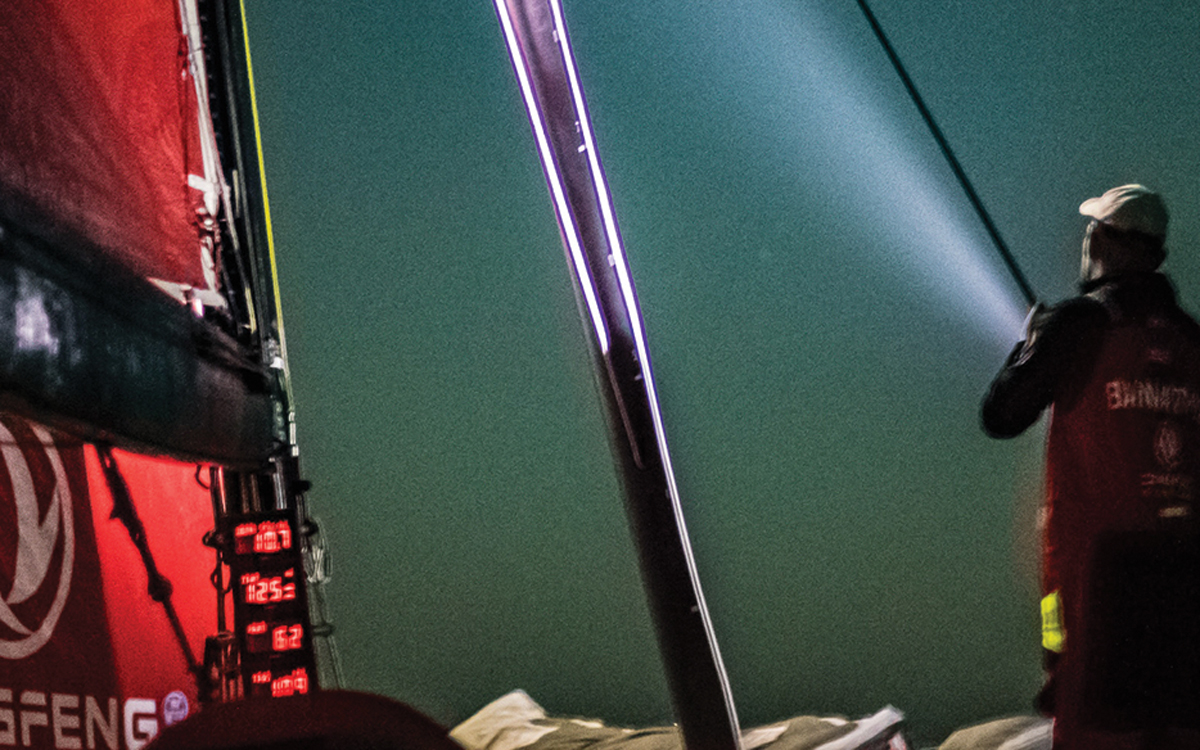Taking headsails down in a hurry can be a fraught time for any sailor – especially at night. These are the times when crew can be easily hurt or sails damaged so the manoeuvres should be well rehearsed. Here are some of my top tips for getting sail down in a hurry, and avoiding common pitfalls
Spinnakers
The first and most important action is to reduce apparent wind as much as possible by sailing fast downwind. This may seem counterintuitive and will require a confident, well-practised helmsman to take control, but the faster you can drive the boat, the less pressure there will be in the spinnaker.
Preparation is key. Ensure all sheets, guys, halyards and tack lines are flaked – even if you are in a panic, taking an extra minute to flake a rope is time well spent. Don’t forget to flake the lazy sheet on a symmetrical spinnaker as this is often the rope that snags. Always brief the crew to ensure everyone knows what type of take-down you will perform in the event of a squall and who will do which job. Run through this regularly – especially before dark.
Free flying spinnakers
If using a spinnaker straight from the bag, I recommend the letterbox drop in high winds. This involves dropping the kite between the mainsail and the boom. This method has the multiple benefits of bringing the sail in directly behind – and therefore in the shadow of – the mainsail, flattening the sail as it squeezes through the gap and giving the take-down team a purchase over which to pull the spinnaker.
To perform a letterbox drop on a symmetrical spinnaker first unroll or hoist the jib, then lead the lazy guy between the main and the boom. Ease the pole forward till it touches the forestay then blow the windward guy and pull on the lazy guy so the spinnaker is pulled round behind the mainsail. Rapidly ease the first 3m of spinnaker halyard to allow the top of the spinnaker to blow away from the mast head, while gathering the foot in under the main.
This initial fast ease of halyard and guy should allow the crew to bring the rest of the sail into the lee of the main. Then ease the halyard at the same pace as the crew pull the spinnaker over the boom.
For an asymmetric the method is the same but initially ease the tack and bring in the pole if using a retractable bowsprit. Unlike a symmetrical spinnaker, once the tack line has blown the asymmetric can remain powered up, so it is vital to gather the foot and collapse the sail as soon as possible. For bigger sails, I recommend using a retrieval line attached to the tack and led aft which will allow the luff to be pulled back quickly.
If sailing short-handed, set the autopilot to steer a steady downwind course on compass mode. Your strongest crew member should gather the sail while the other eases lines. After the initial halyard ease, the second crew can temporarily lock the halyard off to help gather the foot into one sausage; this will slow the drop down but prevent the sail from refilling.
There will be a ‘sweet spot’ to ease the spinnaker halyard to, which will be just enough to allow the entire foot in under the mainsail but not so much that the spinnaker can escape over the side. It is worth practising this move on a calm day to find that spot, then marking the halyard. Whip the rope with white or luminous thread so marks can be seen in the dark.
If flying a spinnaker in squally conditions at night it is a good idea to pre-lead the lazy guy or a separate retrieval line through the boom/mainsail gap so it’s always ready for a drop.
Article continues below…
How to change sails at night: Pip Hare shares her top tips
Before dark As routine, discuss what sail changes may be required overnight then set up as much as possible before…
5 tips: spinnaker drop – how to drop the kite without drama
The leeward drop and mark rounding was looking fine and you were about to nail a few more places, so…
Snuffers
The main challenge with bringing a snuffer down in big breeze is getting the spinnaker to collapse and then avoiding it refilling and forcing the snuffer back up again. Managing this high load alone on the foredeck can be dangerous with the possibility of rope burn, or being physically lifted off the deck by a spinnaker refilling. There are a few ways to manage this risk:
- Feed the snuffer line through a snatch block on the deck so that to drop the sock you have to pull the line up. This will ensure the foredeck crew cannot be lifted off their feet as well as giving a bit of purchase to pull against. If you can find a ratchet block to do this job all the better.
- Ensure the tack/guy and sheet are eased quickly enough for the spinnaker to suddenly collapse.
- When lines are initially eased the spinnaker will remain full and just fly further away from the boat (often overpowering the helm), so the sheet in particular must be fully eased and the foredeck crew needs to wait until the sail collapses before trying to pull the sock down. Good communication is key to this job.
- Finally, consider using a winch to bring the snuffer down. You’ll need long snuffer lines to do this but it is a great technique, particularly if sailing short-handed. Lead the down line through a snatch block on the deck and then up to a mast winch (or back to a cockpit winch) and have it permanently loaded on the winch ready to grind down.
- This is not great for the sail as it can be slow getting into the sock while the sail is flapping but you are guaranteed success in challenging conditions. When solo sailing I always set up my snuffer line on a winch at night. If you regularly sail short-handed it is worth getting snuffer lines extended to enable this method. Watch for bad leads and riding turns.
- Always check your snuffer lines before dark – make sure they are not twisted or the sock has not spun around the head.
Furlers
Furling spinnakers are possibly the easiest to manage in a blow but don’t underestimate how difficult it can be to pull the furling line.
Always have the furling line set up on a winch so it is ready to grind in and make sure the sheets can run free. In conditions where you may need to furl quickly leave the spinnaker halyard at full tension to ensure the torsion cable will work properly when required. Ensure the sheet is fully eased to allow the spinnaker to ‘flag’ out from the torsion cable and avoid the possibility of over-winding parts of the sail.
First published in the September 2019 edition of Yachting World.






